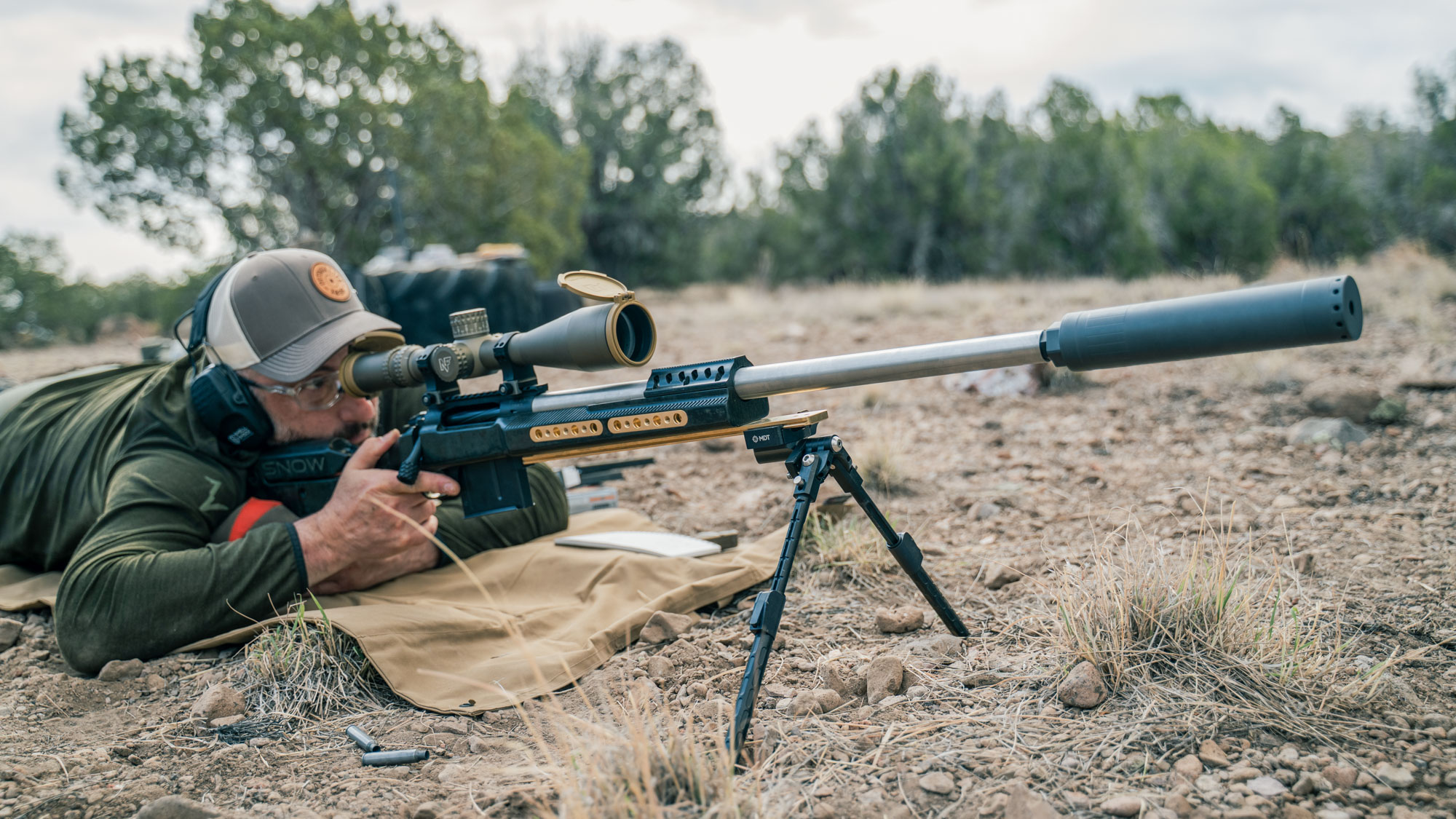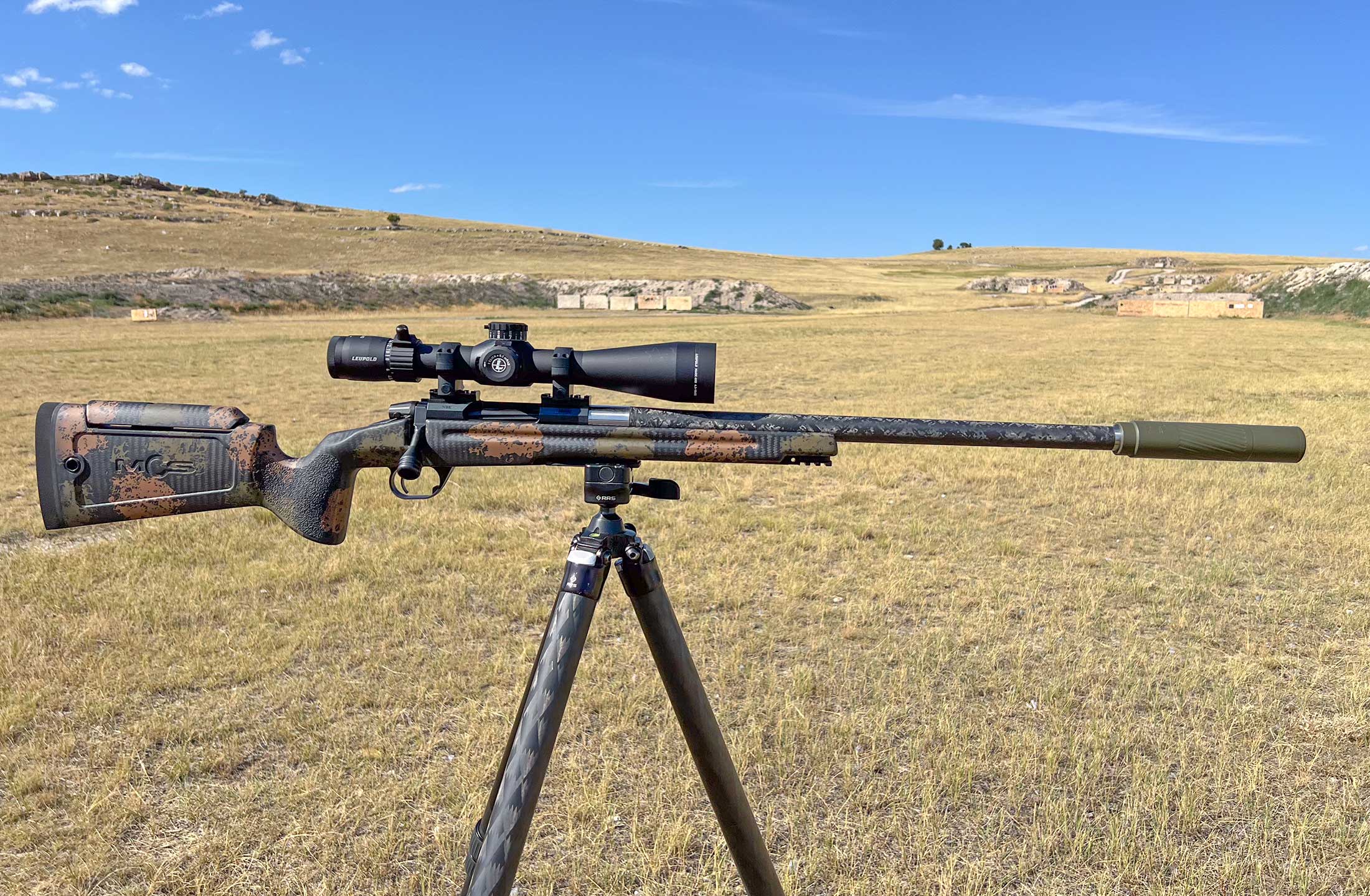The World’s Most Accurate 7mm Backcountry Rifle

The 7mm Backcountry, rolled out by Federal earlier this year, has generated more interest and controversy than any other cartridge introduction in recent memory. Its claim to fame is smoking fast muzzle velocities that cook every other 7mm cartridge out there. It does this by using steel alloy cases — called Peak Alloy by Federal — capable of containing higher pressures than traditional brass.
Sometimes when cartridges are loaded to higher pressures accuracy can suffer, and many people have wondered whether the 7 BC’s speed comes at the cost of precision.
I set out to answer that question by building a heavy-barreled rifle with one goal in mind: squeezing the maximum potential accuracy from the 7mm BC with currently available factory ammo.
Current 7 Backcountry Rifles
We’ve shot a number of 7 BCs to date, and our testing has demonstrated that the cartridge delivers on its promise. When shot through similar rifles, the 7 Backcountry will outpace other 7mm magnums like the 7mm Remington Magnum, 7mm PRC and 28 Nosler — this despite the 7 BC case being noticeably smaller than those other mags.
In practice we’ve seen that through a 20-inch barrel the 7mm BC will equal, or exceed, the muzzle velocities that a 24-inch 7 PRC achieves, making the newcomer a great choice for compact rifles with suppressors. And most firearms companies chambering rifles for the 7 BC are leaning into that idea with highly portable lightweight offerings suited for (naturally) backcountry hunting.
The Proof Glacier Ti is a perfect example. With its carbon fiber stock and carbon-fiber wrapped barrel it is sleek and handy and was the rifle I hunted with most last fall. Like most other 7 Backcountry rifles we’ve tested, it shot the 175-grain Fusion Tipped round the best.
| Rifle | Cartridge | Ammo | 5-Shot Group Avg. | 20-Shot Group ES | Mean Radius | MV (fps) | ES (fps) | SD (fps) |
| Proof Glacier Ti | 7 BC | Fed 175-gr FT | .867 in. | 1.20 in. | .32 in. | 2998 | 14.7 | 5.7 |
The .32-inch mean radius is very good for a hunting rifle, especially one as light as the Proof, which weighs less than six pounds, but I knew that through a rifle purpose-built for long-range precision we’d see even better results.
Assembling the World’s Most Accurate 7mm Backcountry
With the quality of today’s components, which hold super-tight tolerances, it isn’t difficult to build an accurate rifle yourself. As long as you select the right bits and pieces, and assemble them correctly, chances are good you’ll end up with a shooter. I’ve cobbled together many such long guns over the years, and it is a great way to create a rifle that perfectly meets your needs.
For this project, I wanted a rifle mainly designed for prone shooting, with the feature set (and heft) associated with ELR competition guns.
My build used the following:
Proof Research Barrel
I’m no stranger to accurate rifles so I knew where I wanted to start. There are a lot of great barrel makers out there, and one of my top picks is Proof Research, which makes premium cut-rifled barrels. Because I want the rifle to be hefty I chose one of their 24-inch steel competition barrels with a 1:8 twist.
Zermatt TL3 Long Action
I had the barrel cut as a pre-fit for a Zermatt TL3 long action. The TL3 is a smart choice for precision rifle builds; its consistency is second-to-none and its feature set is ideal for long-range shooting. The action has an integral recoil lug, a floating two-lug bolt head with a 90-degree throw, and a full-length Picatinny rail.
The round-body receiver has a Remington 700 footprint and an enclosed ejection port that provides generous access to the chamber, yet retains strength and rigidity.
The TL3 is highly customizable. You can pick right- or left-hand bolt, which side you want the ejection port on, action length, bolt face diameter, the degree of declination desired (if any) on the Pic rail, style of bolt handle, type of magazine cut, thickness of the tang, and the receiver finish. It comes with a bolt release tab on the side of the action and uses an enclosed mechanical ejector.
I did a right-handed long action with a 20 MOA rail, DLC finish on the receiver, medium tang thickness, and AICS magazine cut. For a 7mm Backcountry I used a standard (.478 inch) bolt face, which is compatible with .308 and .30/06 sized cartridges.
Another thing in the TL3’s favor is the ability to swap bolts with different size bolt-faces, making it easy to convert from one cartridge to another. Since so many barrel makers have pre-fits for the TL3 it is ideal for a multi-caliber build, especially for one like this, which I’ll use as a platform to test the accuracy of other long-action cartridges down the road.
Foundation Sampson Stock
The key feature that separates Foundation stocks from others is that they are machined from solid Micarta composite. In addition to being rigid and impervious to the environment, they are dense and have a distinctive “dead” feel under recoil. Other stock materials —— aluminum, fiberglass, or carbon fiber —— can vibrate when recoiling (in the worst cases imparting a “tuning fork” sensation) but Foundation stocks feel utterly inert. This translates into excellent recoil management and shooter feedback.
Foundation stocks, like the Centurion and Genesis, have been a mainstay on the PRS circuit for years, blending fine ergonomics with the heft, durability, and accuracy that sport demands. The company’s founder, John-Kyle Truitt, launched the Samson stock a little over a year ago. It is designed for ELR work and is highly customizable.
I went all in to maximize the stock’s weight, choosing the brass (rather than aluminum) ARCA rail with the extra brass weights. The stock also comes with a Micarta barrel bridge, adjustable recoil pad and cheek piece, and ambidextrous thumb shelf.
Hawkins Precision Bottom Metal and MDT Magazines
Many high-end rifle companies and custom gun makers use Hawkins components in their builds, and who am I to argue against their collective wisdom? I’ve been a fan of Hawkins for many years, and they were a natural choice for this build.
Their M5 bottom metal is available in at least five different lengths and the short-action version will work with AW style magazines in addition to AICS pattern mags.
Their long-action bottom metal, which I used, is AICS only and works with AICS, Accurate, and MDT magazines. The 7mm Backcountry, being a long and skinny round, works best with mags for the .30/06. MDT makes some excellent .30/06-sized magazines, and I used their 3.715-inch model. Paired with the Hawkins bottom metal, the MDT magazine feeds the 7mm Backcountry smoothly and reliably.
TriggerTech Diamond Trigger
Good precision rifles need quality triggers, and the TriggerTech Diamond is the most popular choice among top long-range competitors. The single-stage Diamond can be tuned to trip between 4 and 32 ounces, and I set mine at 1 pound, 15 ounces. It is crisp and consistent, giving the shooter excellent control over the break of the shot. TriggerTech also makes a double-stage Remington 700 pattern trigger that adjusts from 4 to 20 ounces for the first stage and from four to 24 ounces for the second stage — if that’s your thing.
Nightforce 7-35×56 ATACR Scope
There are many fabulous precision scopes to choose from, with more being introduced each year. That said, the Nightforce ATACR is a stalwart in the long-range game and remains a top choice thanks to its good glass, crisp and positive controls, precise tracking, 29 mils of elevation travel, and bomb-proof construction.
Yes, the scope is heavy, but in this case that is a feature and not a bug. I’m also a huge fan of the Mil-XT reticle, which strikes a just-right balance between the amount of information it conveys and its usability. It has ample windage and elevation reference marks that are easy to navigate without being overly cluttered. The ATACR and Mil-XT combo is still one of the best options for field-style long-range shooting and sniper competitions.
I secured the ATACR to the rifle with Nightforce Ultralight 34mm rings. They might not look as substantial as some other precision-rifle rings and mounts but don’t let that fool you. I’ve found them to be utterly reliable and never hesitate to use them when peak accuracy is the goal.
7mm Backcountry Performance
So far, I’ve put just over 200 rounds through the rifle and it has lived up to my expectations. Included in that round count were six 20-shot strings to gather accuracy and velocity data.
The data for each load was gathered by shooting four 5-shot groups and then overlaying them to form a 20-shot aggregate. With the help of the Group Analysis feature in Hornady’s 4DOF app, we’re able to calculate the extreme spread of the 20 shots as well as the mean radius of each group. In addition, I captured velocity data with a Garmin Xero C1 Pro chronograph, which has been a game changer for this kind of work thanks to its simplicity and reliability.
| Ammo | 5-Shot Group Avg. | 20-Shot Group ES | Mean Radius | MV (fps) | ES (fps) | SD (fps) |
| Fed 175-gr FT | .464 in. | .81 in. | .22 in. | 3043 | 52.7 | 12.5 |
| Fed 175-gr FT | .713 in. | 1.05 in. | .26 in. | 3055 | 77.9 | 16 |
| Fed 170-gr TA | .910 in. | 1.09 in. | .32 in. | 3183 | 79.4 | 20.8 |
| Fed 170-gr TA | 1.175 in. | 1.18 in. | .35 in. | 3165 | 61.8 | 16 |
| Fed 168-gr Brn LRX | .933 in. | 1.31 in. | .37 in. | 3144 | 41.5 | 10.8 |
| Fed 168-gr Brn LRX | 1.221 in. | 1.56 in. | .40 in. | 3120 | 28.9 | 8.4 |
Interpreting the Data
Five-shot groups have been a standard for judging rifle accuracy for decades, but we’ve come to realize they aren’t as useful as we thought. Put simply, a five-shot sample has too great a margin for error to be reliable. By upping the data set to 20 shots, we dramatically improve the quality of the information, whether looking at dispersion (group size) or velocity. This is statistics 101.
But even more meaningful than the extreme spread (ES) of a group, which is based on the performance of the worst two of the 20 shots, is mean radius (MR). To generate the mean radius, the Hornady App determines the mathematical center of the group and then calculates the average distance (mean) from that point that each shot impacts. This average is more valid as a predictive tool than group size since it uses data from 20 shots, rather than two.
And you can see how the five-shot data jumps around in relation to the mean radius, while the 20-shot group ES tracks more consistently with the MR. We’ve written in-depth about mean radius, and how to generate and use 20-shot groups, if you want to learn more.
Giving Meaning to the Numbers
In practical terms, any mean radius around .40 inches is shooting pretty well and is more than capable for general hunting. When you get to .30 inches or so, you’re dealing with ammo that’s delivering very good performance — in this case printing a 20-shot group a touch larger than one inch. If the MR is at .25 inches, or better, we’re looking at exceptional accuracy. That’s a load capable of making the most demanding shots, as long as the velocities are consistent. (MRs at .20 inches and smaller is the hallmark of very high-quality match ammunition.)
Regarding velocity, factory ammunition with 20-shot SDs in the teens is excellent. That’s about as good as factory ammo gets, though sometimes you’ll see better. SDs in the twenties are perfectly acceptable as well, and you shouldn’t hesitate to take that load on your next hunt. Low SDs are desirable as they translate to consistent bullet drop at distance.
How Well Does the 7 BC Shoot?
I’ve been really impressed with Federal’s 175-grain Fusion Tipped bullet. The numbers it put up — MRs of .22 and .26 inches — are outstanding. The SDs are also excellent. This load has consistently been the best performer in just about every 7 BC rifle we’ve shot so far (eight and counting). With an average muzzle velocity around 3050 fps from a 24-inch barrel it is stepping out in style too.
The 170-grain Terminal Ascent is no slouch either. Its MRs of .32 and .35 inches are indicative of fine accuracy. The SDs on that ammo, while a touch higher than the Fusion Tipped, still qualify as very good, and the 3175-fps muzzle velocity is blistering.
The 168-grain Barnes LRX load is also solid. The 3135-fps MV packs a wallop and the SDs, hovering around 10 fps, are phenomenal. This round’s precision, with MRs at .37 and .40 inches, is on par with average factory rifles. While some rifles love monometal projectiles, it is more common than not to see high-quality lead-core bullets outshoot their copper alloy counterparts.
The 7mm BC at 1000 Yards and Beyond
While we punched a lot of paper with the 7 Backcountry to gather this info, we didn’t neglect to shoot it at longer distances. When I zeroed my Proof Glacier before chasing elk, I shot it out to 1,100 yards and had no difficulty banging steel with the 175-grain Fusion Tipped at that range.
This heavy-barreled custom build extends the 7 BC’s practical range further. During a trip to Gunsite Academy in March, the most distant piece of steel we located was at 1,450 yards, and we were able to ring it consistently.
Soon, Federal will go into production with a 195-grain Berger load and, once that arrives, I suspect it will be the go-to for this kind of shooting, but for now the Fusion Tipped rules the roost.
Uneasy Rests the Crown
For now, I have no qualms proclaiming to have the world’s most accurate 7mm Backcountry. I got a jump on the rest of the pack with this rifle from a desire to ascertain the accuracy potential of the round, and happily the components gelled as well as I had hoped.
As I mentioned above, I plan to get more barrels for this Zermatt TL3 and use it as a go-to platform to test other cartridges and bullets.
Eventually, I’m sure someone will assemble a 7 Backcountry that will dethrone my build, but for the moment this rifle is king of the hill.
Read the full article here









